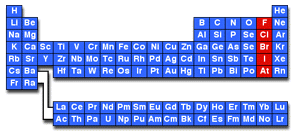HALOGENS
The elements
The halogen group (17) is mainly electronegative within the periodic table and all elements readily create halide ions X-. In chemistry the trends resemble those found in another groups. Fluorine is limited to an octet of valence electrons. It is mainly reactive and electronegative of all elements and frequently (like with oxygen) takes out the highest oxidation state in other elements: instances in which no corresponding oxide is known include PtF6 and AuF5 .
F and Cl are fairly abundant elements, main sources being halite NaCl and fluorite CaF2, from which the extremely electronegative elements are obtained through electrolysis. Bromine is mostly obtained through oxidation of Br- found in salt water; iodine takes place as iodates like Ca(IO3)2. Astatine is radioactive and only minute amounts are observe in nature.

Chlorine is employed (as ClO- and ClO2) in bleaches and is a significant industrial chemical, other main uses (like with all the halogens) being within the manufacture of halogenated organic compounds.
The elements create diatomic molecules, F2 and Cl2 being gases at usual temperature and pressure, Br2 liquid and I2 solid. They react directly with most another elements and are good oxidizing agents, even though reactivity declines down the group. X-X bond strengths follow the sequence that is as follow F<Cl>Br>I.